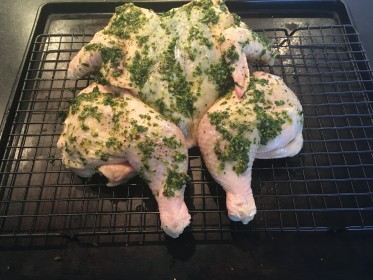My son loves to host our family’s Easter dinner, but he waits until only days before to decide on the menu. Typically, he calls, pondering choices, aloud with me on the phone. Our conversation this year went like this. Should he serve traditional leg of lamb–no, he exclaims the kids (the 11 and 13 year old) and his wife are not big fans! Baked ham–scratch that since we had it last year! Roast beef tenderloin–oops that was our Christmas main course. Finally, I offer a suggestion. What about spatchcocked roast chicken? After a long pause, he requests the recipe!
Earlier this month I taught a cooking class in which students learned to master the simple technique of spatchcocking a whole chicken. You remove the backbone with a pair of kitchen shears and then open the chicken out like a book and press down on the breast to flatten it. Prepared this way, the chicken cooks more quickly and evenly, a big advantage on a day like Easter Sunday.
For my version, a puree of fresh herbs, garlic, lemon, and olive oil is rubbed under the breast skin and then over the bird before it is arranged on a flat rack on a baking sheet. The roasting time is about 45 minutes, and yields a bird that is golden brown and herb flecked with extra moist flesh. Served with roasted or blanched asparagus, it makes a beautiful holiday dish. Maybe you’ll vote for it too!
 Print This Recipe
Print This Recipe
Spatchcocked Roast Chicken with Fresh Rosemary, Parsley and Sage
2 tsp chopped garlic
1 tsp fennel seeds, crushed (see cooking tip)
2 tbsp chopped flat leaf parsley
1 1/2 tbsp chopped fresh rosemary
1 tbsp chopped fresh sage
1/8 tsp red pepper flakes, plus more if needed
2 tsp grated lemon zest
6 tbsp olive oil. plus extra if needed
One 4 1/2 lb chicken with any packets or extra parts removed from the cavity and saved for another use (See note.)
2 tsp kosher salt
1/2 tsp freshly ground black pepper
Juice of 1/2 lemon
Garnishes
2 tbsp chopped parsley
1 tbsp chopped fresh rosemary
Fleur de sel
6 lemon wedges
Special equipment needed: good kitchen shears
1. Arrange a rack at center position and preheat over to 425 degrees F. Place an ovenproof wire rack on top of a rimmed baking sheet.
2. Set chicken on a work surface with breast side down and legs and thighs nearest you. Using kitchen shears, make parallel cuts along each side of the backbone. If you hit a bone that is hard to cut through, turn the chicken around so the neck is nearest you and cut from that direction. Save backbone for stock or discard. Turn bird over and flatten breast area by pressing down firmly with your hands.
3. In a food processor, pulse together garlic, fennel seeds, 2 tablespoons parsley, 1 1/2 teaspoons rosemary, sage, red pepper flakes, lemon zest, and 2 tablespoons of the olive oil to form a coarse puree.
4. Starting at neck end of the chicken, carefully slide your fingers between the skin and breast meat to loosen skin. Pat half of the herb mixture over the breast meat under the skin. Then brush chicken generously with 2 tablespoons of olive oil. Pat or brush the remaining herb mixture over breast, thighs, legs, and wings. Season chicken with 2 teaspoons salt and 1/2 teaspoon black pepper.
5. Place chicken on rack and roast 25 minutes. Then brush chicken with remaining 2 tablespoons oil and squeeze the juice of 1/2 lemon over the bird. Continue to roast until an instant read thermometer registers 165 to 170 when inserted into the thighs and juices run clear, 15 to 20 minutes more, brushing with extra oil if needed. Remove from oven and let stand 10 minutes on rack.
6. Carve chicken into serving pieces and arrange on a platter. Sprinkle with parsley, rosemary and a touch of fleur de sel. Garnish with lemon wedges. Serves 5 to 6.
Note: I like Bell and Evans organic chickens available at my local Whole Foods. They are air chilled and very moist when roasted. And, the butchers will spatchcock the chicken for you if you are pressed for time.
Note:To crush fennel seeds, place them in a mortar and crush with a pestle, or grind them in an electric spice grinder. Or, place them in a self-sealing plastic bag and pound them with a meat pounder or rolling pin. The seeds should be finely crushed unless the recipe calls for coarsely crushed ones.
Copyright Betty Rosbottom 2016







